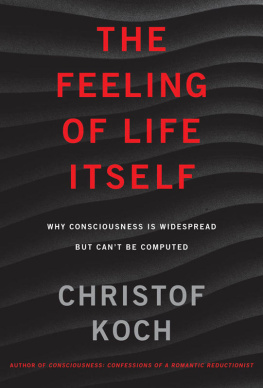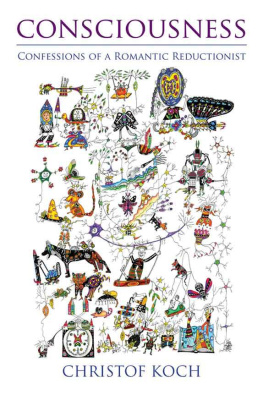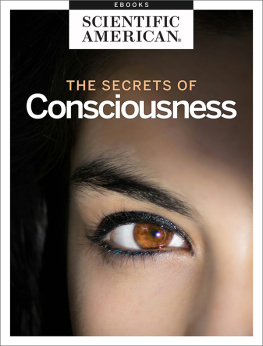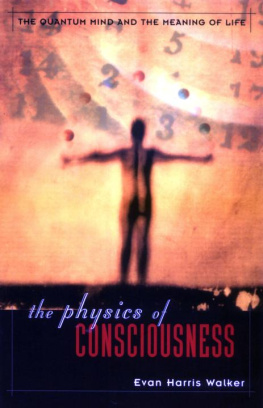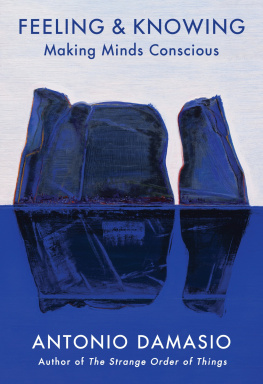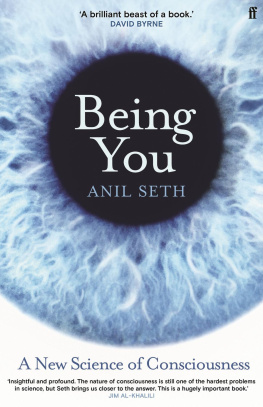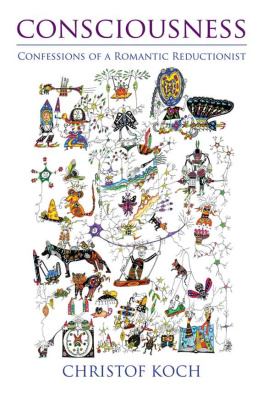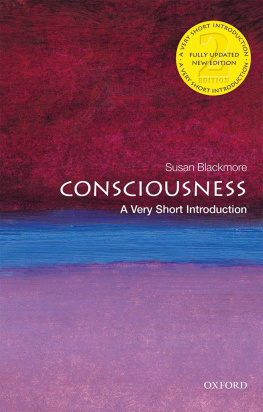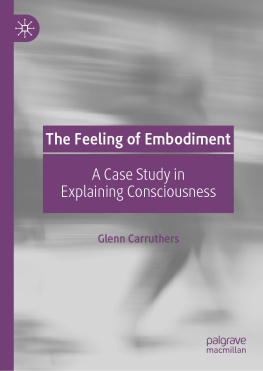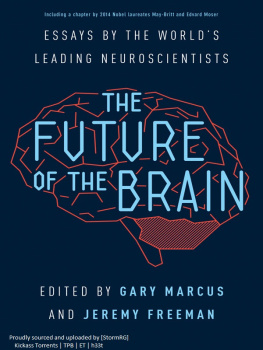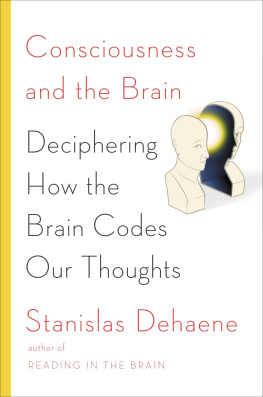The Feeling of Life Itself
Why Consciousness Is Widespread but Cant Be Computed
Christof Koch
The MIT Press
Cambridge, Massachusetts
London, England
2019 Massachusetts Institute of Technology
All rights reserved. No part of this book may be reproduced in any form by any electronic or mechanical means (including photocopying, recording, or information storage and retrieval) without permission in writing from the publisher.
This book was set in Stone Serif and Stone Sans by Westchester Publishing Services. Printed and bound in the United States of America.
Library of Congress Cataloging-in-Publication Data is available.
ISBN: 978-0-262-04281-9
To Teresa
Life is not a series of gig lamps symmetrically arranged; life is a luminous halo, a semi-transparent envelope surrounding us from the beginning of consciousness to the end.
from Virginia Woolfs 1921 essay Modern Fiction
Contents
List of Figures
Inner perspective: The world as seen through my left eyeincluding a portion of my eyebrow and nose, and my dog, Ruby, sitting on a lounge chair and looking at me. The extent to which this percept is congruent with reality is ultimately open; perhaps I am hallucinating. But it is a drawing of my conscious visual experience, the only reality I have direct acquaintance with.
Probing experience: Images of faces or butterflies are made easy or more difficult to recognize by overlaying visual noise while you push a button, indicating whether you saw a face or a butterfly. For any one level of such noise, trials when the stimulus is correctly perceived are compared to those when you failed to do so, even though the same picture was present on your retina. (Adapted from Genetti et al., 2011.)
Mouse and human neurons: Two human and two mouse neocortical neurons from the Allen Institute of Brain Science. Their morphologies are similar, except that human cells are taller. (Data provided by Staci Sorensen at the Allen Institute.)
The unconscious homunculus: You are conscious neither of raw sensory data, whether originating outside or from within your body, nor of the highest processing stages of the mind, what Francis Crick and I call the unconscious homunculus, the inner source of creativity, thought, and intelligence. The vast majority of your experiences are sensory-spatial in character (white annulus). The arrows denote sensory and motor pathways that connect the brain to the world.
Brain waves: Different brain statesalert, excited, drowsy, deeply asleep, dreamingare reflected in distinct patterns of EEG activity measured by electrodes across the scalp. They are diagnostic of different states of consciousness in health and disease. (Redrawn from Dement & Vaughan, 1999.)
The neural correlates of consciousness: In the cartoon on the left, a flashed ambiguous image can be seen either as a face or as a nebulous black-and-white something. Contrasting the brain activity for these two percepts while you lie in a magnetic scanner identifies the content-specific NCC for the experience of seeing faces. A different experiment (on the right) compares brain activity when lying in a scanner with eyes closed to activity when you are deeply asleep. This pinpoints regions involved in the state of being conscious (the full NCC).
The brainstem as a background condition for consciousness: The brainstem reticular formation, spanning the medulla, pons, and midbrain (right), houses more than forty nuclei (left). Collectively, they regulate sleep and wakefulness, arousal, breathing and heart rate, temperature, eye movements, and other critical functions. Its neurons enable experience but do not provide the content for any one experience. The size of each rectangle reflects the relative size of each nucleus within the brainstem. (Redrawn from Parvizi & Damasio, 2001.)
A Purkinje cell of the human cerebellum: Its striking coral-shaped dendritic tree receives input from several hundred thousand synapses. About ten million Purkinje cells provide the sole output of the cerebellum. Yet none of this circuitry generates conscious experience. (Redrawn from Piersol, 1913.)
Living without a cerebellum: Drawing of a structural scan of a woman born with a gaping hole, filled with cerebrospinal fluid, where her cerebellum ought to be. Despite various motor deficits, she is conscious. (Adapted from Yu et al., 2014.)
The neocortical sheet: Neocortex is a vast lace of pyramidal neurons and interneurons. The chiaroscuro pattern of cell bodies in the middle drawing, oriented from top to bottom, resolves into six layers that make up this structure. Shaped like a highly folded pizza or pancake, it forms the cortexs gray matter (right). The electrical activity of its neurons is the physical substrate of experience.
Eloquent cortex: Resecting primary sensory or motor cortices on either side, Brocas area in the left inferior frontal gyrus, or Wernickes area in the left superior temporal gyrus causes permanent sensory, motor, or linguistic deficits. These regions are collectively known as eloquent cortex. Less appreciated is the conversethat large regions of prefrontal cortex can be surgically removed without apparent ill effect on conscious experience.
The geography of the posterior hot zone: Electrically stimulating the back of cortex can reliably trigger conscious sensations, demonstrated here in three exemplar studies. The drawings depict the left hemisphere as seen from three different directions, with P (for posterior) indicating the back of the brain and A (for anterior) its front. The medial view (upper-left) highlights stimulation that elicits visual percepts in occipital regions and motor responses once past the cingulate sulcus. The lateral view (lower-left) marks locations in posterior parietal cortex that trigger a conscious desire to act or move specific limbs. Stimulating sites within the fusiform gyrus on the bottom of cortex (right) causes distortions when seeing faces. (Upper-left image redrawn from Foster & Parvizi, 2017; lower-left image from Desmurget et al., 2009; image on right from Rangarajan et al., 2014.)
Experiential responses from the temporal lobe: Locations on the cortical surface where electrical stimulation by the neurosurgeon Wilder Penfield evoked experiences. There is a clear bias for the nondominant right hemisphere. Most of these complex visual and auditory hallucinations are triggered from the superior temporal gyrus; some can be triggered from other temporal regions or from parieto-occipital regions. Stimulation of the rest of the cortical windings did not evoke experiential responses in more than five hundred patients. (Redrawn from Penfield & Perot, 1963.)
Leibnizs mill argument updated to the twenty-first century: Over three hundred years ago, Leibniz pointed out that no matter how closely we zoom in to the bodyepitomized by the most advanced technology of his day, windmillswe will never find experience but only levers, gears, shafts, and other mechanisms. Using todays instruments, we can indeed peer at the smallest organelles of the brain, the synapses (arrows), here in an electron-microscopic image of cerebral cortex. Where does experience hide? The bar indicates 1/1000th of a millimeter.
A web of causal relations: For any physical system that obeys all five phenomenological axioms, integrated information theory unfolds an associated intrinsic cause-effect structure illustrated using a labyrinthine spider web. The central identify of IIT claims that what it feels like to be this system in this state is identical to the set of causal relationships that compose this structure.
Next page
